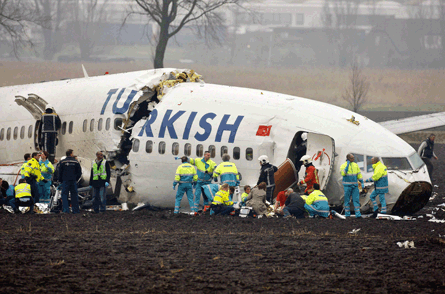The immediacy of new media is now major factor for airline management and safety regulators as Twitter, the instant-messaging, for immediate-broadcast email service, claims its place as the first source of public word of airline disasters.
When a Turkish Airlines Boeing 737 landed short and broke apart at Amsterdam's Schipol on 25 February, the first word to the public was a 'Tweet,' sent out by a fellow who lives near the airport. "Looking at a crashed aeroplane near Schipol," he Twittered within minutes of the Flight 1951's impact - which killed at least nine people.
 |
|---|
© PA Photos |
Users of Twitter sometimes arrive on the scene before first responders and in one case it was a crash survivor who 'Tweeted' from the scene of the crash of a Continental Airlines Boeing 737 last December. But even though this may be an advance for 'citizen journalism' and indeed for social media, it adds complications.
Peter Goelz, a former National Transportation Safety Board managing director, says, "This is a remarkable development that makes the entire process more complicated. The safety board is going to have to pay attention," he says, to such things as the reliability of accident witnesses who may have been influenced by Tweets. Goelz is now a Washington consulant.
Jerry Hendin, director of crisis communications for Kenyon International, says, "It changes the entire gold standard of airlines, which had always held themselves to getting out accurate information on an accident or incident within 60 minutes.
Not only will airlines be under more pressure to act quickly, but they also have to face the fact that Twitter is less regulated than other media," he says, noting that a message, even one as short as a 140-character Tweet, is inherently interpretive - unlike, for instance, a picture taken on a cell phone and posted to the Internet.
The first words and pictures of the US Airways A320 that ditched in the Hudson River in New York City last month came as a Twitter communicated from a ferry boat headed to rescue the 155 who survived. Even though the very first was from an eyewitness, some of the survivors of Flight 1549 soon Tweeted. Morgan Durrant, a US Airways spokesman, says that the Twitters increase the workload of the corporate communications department, although in the case of Flight 1549, "we were all lucky".
This is a rapidly developing trend, spurred since the immediacy of last December's historic Tweet - by a passenger who was on board the Continental flight that skidded off of a Denver runway and burst into flames. He Tweeted, starting with 'I WAS JUST IN PLANE CRASH' right after he got out of the plane and was standing near the runway, waiting to be rescued.
And, Hendin adds, managers and regulators "don't always know who they're reading or what he or she knows. You're put in the position of having to respond in some cases to what people think they've seen".
Many of the Flight staff already Twitter, check out their news and views at Twitter.com.
- Twitter.com/flightglobal
- Twitter.com/flightblogger
- Twitter.com/theABed
- Twitter.com/victoriaonair
- Twitter.com/runwaygirl
And many more
Source: Airline Business



















